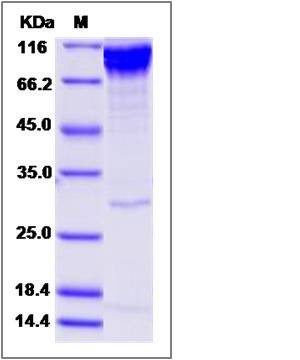Human ECD / Ecdysoneless homolog Protein (His & GST Tag)
ECD,GCR2,HSGT1
- 100ug (NPP2091) Please inquiry
| Catalog Number | P14311-H20B |
|---|---|
| Organism Species | Human |
| Host | Baculovirus-Insect Cells |
| Synonyms | ECD,GCR2,HSGT1 |
| Molecular Weight | The recombinant human ECD/GST chimera consists of 881 amino acids and has a calculated molecular mass of 100.6 kDa. The recombinant protein migrates as an approximately 88-108 kDa band in SDS-PAGE under reducing conditions. |
| predicted N | Met |
| SDS-PAGE |  |
| Purity | > 90 % as determined by SDS-PAGE |
| Protein Construction | A DNA sequence encoding the human ECD (O95905-1) (Met1-Thr621) was expressed with the N-terminal polyhistidine-tagged GST tag at the N-terminus. |
| Bio-activity | |
| Research Area | Immunology |Signal Transduction |Cellular Senescence and Pathways in Aging |Apoptosis |Apoptosis Receptors |Associated Proteins | |
| Formulation | Lyophilized from sterile 20mM Tris, 500mM NaCl, 10% glycerol, pH 7.4. 1. Normally 5 % - 8 % trehalose, mannitol and 0.01% Tween80 are added as protectants before lyophilization. Specific concentrations are included in the hardcopy of COA. |
| Background | ECD, also known as ecdysoneless homolog, belongs to the SGT1 family. It is highly expressed in muscle and heart. ECD is a novel promoter of mammalian cell cycle progression. This function is related to its ability to remove the repressive effects of Rb-family tumor suppressors on E2F transcription factors. It is a novel tumor-promoting factor that is differentially expressed in pancreatic cancer and potentially regulates glucose metabolism within cancer cells. ECD may also be a transcriptional activator required for the expression of glycolytic genes. |
| Reference |
